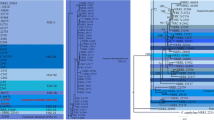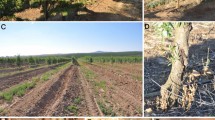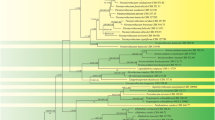Abstract
Four trichothecene-producing strains originally isolated from diseased wheat and a vinyl plate in Kyushu and Shikoku, Japan are described and illustrated as a new species,Fusarium kyushuense. This species does not produce chalamydospores, which is the key morphological character which distinguishes it fromF. sporotrichioides with which it has been mistaken.Fusarium kyushuense is also differentiated from another morphologically similar species,F. arthrosporioides, by absence of sclerotia and by differences in conidiogenesis of obovate, conidia. InF. arthrosporioides conidia are partly holoblastic from the aerial conidiophores and mostly phialidic from the sporodochial conidiophores, while inF. kyushuense conidia are mostly holoblastic and only produced from aerial conidiophores.
Similar content being viewed by others
Literature cited
Booth, C. 1971. The genusFusarium. CMI, Kew, Surrey.
Burgess, L. W., Nelson, P. E. and Toussoun, T. A. 1982. Characterization, geographic distribution, and ecology ofFusarium crookwellense sp. nov. Trans. Br. Mycol. Soc.79: 497–505.
Gerlach, W. and Nirenberg, H. 1982. The genusFusarium-2 pictorial atlas. Mitt. Biol. Bundesanst. Land-u. Forstwirtsch. Berlin-Dahlem209: 1–406.
Kornerup, A. and Wanscher, J. H. 1978. Methuen handbook of colour, 3rd ed. Eyre Methuen, London.
Marasas, W. F. O., Nelson, P. E. and Toussoun, T. A. 1984. ToxigenicFusarium species: Identity and mycotoxicology. Pennsylvania State University, University Park, PA.
Mulé, G., Logrieco, A., Stea, G. and Bottalico, A. 1997. Clustering of trichothecene-producingFusarium strains determined from 28S ribosomal DNA sequences. Appl. Environ. Microbiol.63: 1843–1846.
Nirenberg, H. I. 1990. Recent advances in the taxonomy ofFusarium. Stud. Mycol.32: 91–101.
Nirenberg, H. I. and Aoki, T. 1997.Fusarium nisikadoi, a new species from Japan. Mycoscience38: 329–333.
O’Donnell, K. 1997. Phylogenetic evidence indicates the important mycotoxigenic strains Fn-2, Fn-3, Fn-2B and Fn-M represent a new species ofFusarium. Mycotoxins (Tokyo)45: 1–10.
O’Donnell, K. and Cigelnik, E. 1997. Two divergent intragenomic rDNA ITS2 types within a monophyletic lineage of the fungusFusarium are nonorthologous. Mol. Phylo. Evol.7: 103–116.
Seemüller, E. 1968. Untersuchung über die morphologische und biologische Differenzierung in derFusarium-SektionSporotrichiella. Mitt. Biol. Bundesanst. Land-u. Forstwirtsch. Berlin-Dahlem127: 1–93.
Sherbakoff, C. D. 1915. Fusaria of potatoes. Mem. Cornell Univ. Agric. Exp. Stat.6: 87–270.
Tatsuno, T., Morita, Y., Tsunoda, H. and Umeda, M. 1970. Recherches toxicologiques des substances métaboliques duFusarium nivale VII. La troisième substance métabolique deF. nivale, le diacétate de nivalenol. Chem. Pharm. Bull.18: 1485–1487.
Tatsuno, T., Saito, M., Enomoto, M. and Tsunoda, H. 1968. Nivalenol, a toxic principle ofFusarium nivale. Chem. Pharm. Bull.16: 2519–2520.
Tsunoda, H. 1970. Micro-organisms which deteriorate stored cereals and grains. In: Toxic micro-organisms, (ed. by Herzberg, M.), pp. 143–162. UJNR/U. S. Dept. of Interior, Washington, D.C.
Tsunoda, H., Toyazaki, N., Morooka, N., Nakano, N., Yoshiyama, H., Okubo, K. and Isoda, M. 1968. Researches on the micro-organisms which deteriorate the stored cereals and grains (34). Detection of injurious strains and properties of their toxic substances of scabFusarium blight growth on the wheat. Proc. Food Res. Inst. (Minist. Agr. Forest. Japan)23: 89–116. (in Japanese).
Ueno, Y. 1971. Toxicological and biological properties of fusarenon-X, a cytotoxic mycotoxin ofFusarium nivale Fn-2B. In: Mycotoxins in human health, (ed. by Purchase, I. F. H.), pp. 163–178. Macmillan. London.
Ueno, Y., Ishikawa, Y., Nakajima, M., Sakai, K., Ishii, K., Tsunoda, H., Saito, M., Enomoto, M., Ohtsubo, K. and Umeda, M. 1971. Toxicological approaches to the metabolites of Fusaria. I. Screening of toxic strains. Jpn. J. Exp. Med.41: 257–272.
Ueno, Y., Ueno, I., Tatsuno, T., Ohkubo, K. and Tsunoda, H. 1969. Fusarenon-X, a toxic principle ofRusarium nivale culture filtrate. Experientia25: 1062.
Wollenweber, H. W. and Reinking, O. A. 1935. Die Fusarien, ihre Beschreibung, Schadwirkung und Bekämpfung. Paul Parey, Berlin.
Author information
Authors and Affiliations
About this article
Cite this article
Aoki, T., O’Donnell, K. Fusarium kyushuense sp. nov. from Japan. Mycoscience 39, 1–6 (1998). https://doi.org/10.1007/BF02461571
Accepted:
Issue Date:
DOI: https://doi.org/10.1007/BF02461571




